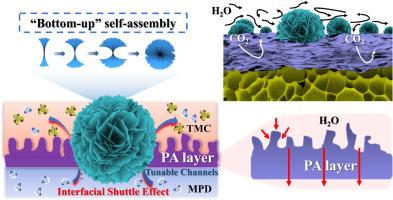Self-assembled nanoflower-mediated interfacial polymerization through tunable intra- and inter-layer channels to boost total heat exchange performance
IF 8.4
1区 工程技术
Q1 ENGINEERING, CHEMICAL
引用次数: 0
Abstract
Total heat exchange membranes (THEMs) are vital for minimizing energy consumption and enhancing indoor air quality in energy recovery ventilation (ERV) systems. Manipulating the surface morphology of polyamide (PA) membranes via nanofiller-mediated interfacial polymerization is key to advancing total heat recovery performance. This study presented the fabrication of PA thin-film nanocomposite (TFN) membranes by integrating self-assembled poly(amic acid-imide) nanoflowers (P(AA-I)-NFs) with intertwined nanosheets into the organic phase. This facile approach effectively eliminated nonselective interphase voids and defects, owing to the superior polymer affinity of the organic nanoflowers. The finely tuned intra- and inter-layer channels within P(AA-I)-NFs significantly impacted monomer mass transfer, facilitated the shuttle effect, expanded the interfacial polymerization zone, and led to the formation of a rougher, thicker PA layer with enhanced surface area. The optimized P(AA-I)-NFs/PA TFN membranes exhibited outstanding performance, including CO₂ permeability of 0.51 GPU, water vapor permeability of 656.59 GPU, and an enthalpy exchange efficiency of 71.47 %, surpassing the trade-off limitations typically observed in commercial and other advanced THEMs. These findings underscored the potential of P(AA-I)-NFs-mediated TFN membranes as highly competitive candidates for next-generation ERV systems.

通过可调的层内和层间通道实现自组装纳米花介导的界面聚合,从而提高总热交换性能
在能量回收通风系统(ERV)中,全热交换膜(THEMs)对于最大限度地降低能耗和提高室内空气质量至关重要。通过纳米填料介导的界面聚合来操纵聚酰胺(PA)膜的表面形态是提高全热回收性能的关键。本研究介绍了通过将自组装聚(AA-I)纳米流(P(AA-I)-NFs)与相互交织的纳米片整合到有机相中来制造聚酰胺薄膜纳米复合材料(TFN)膜。由于有机纳米花具有优异的聚合物亲和性,这种简便的方法有效地消除了非选择性相间空隙和缺陷。P(AA-I)-NFs 中经过微调的层内和层间通道极大地影响了单体的传质,促进了穿梭效应,扩大了界面聚合区,并形成了具有更大表面积的更粗糙、更厚的 PA 层。优化后的 P(AA-I)-NFs/PA TFN 膜表现出卓越的性能,包括 0.51 GPU 的 CO₂渗透率、656.59 GPU 的水蒸气渗透率和 71.47 % 的焓交换效率,超越了通常在商业和其他先进 THEM 中观察到的权衡限制。这些发现凸显了 P(AA-I)-NFs 介导的 TFN 膜作为下一代 ERV 系统极具竞争力的候选材料的潜力。
本文章由计算机程序翻译,如有差异,请以英文原文为准。
求助全文
约1分钟内获得全文
求助全文
来源期刊

Journal of Membrane Science
工程技术-高分子科学
CiteScore
17.10
自引率
17.90%
发文量
1031
审稿时长
2.5 months
期刊介绍:
The Journal of Membrane Science is a publication that focuses on membrane systems and is aimed at academic and industrial chemists, chemical engineers, materials scientists, and membranologists. It publishes original research and reviews on various aspects of membrane transport, membrane formation/structure, fouling, module/process design, and processes/applications. The journal primarily focuses on the structure, function, and performance of non-biological membranes but also includes papers that relate to biological membranes. The Journal of Membrane Science publishes Full Text Papers, State-of-the-Art Reviews, Letters to the Editor, and Perspectives.
 求助内容:
求助内容: 应助结果提醒方式:
应助结果提醒方式:


